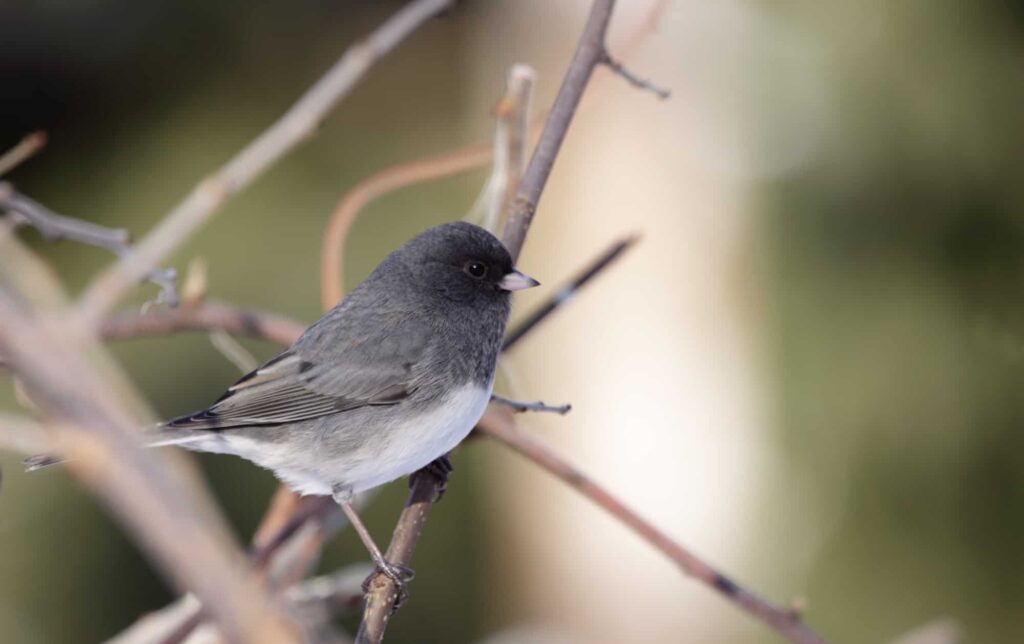Its nickname ‘The Prairie State’ paints a picture of what types of landscapes you can expect to see in Illinois. Gentle rolling hills, wetland meadows, mixed forests, and plentiful lakes can all be found here, as well as the significant coastline of Lake Michigan in the north.
These rich landscapes have a big impact on which bird species can be found here, and 22 out of the 200+ birds that are seen in Illinois are sparrows. From wetlands, to dry grasslands, to inner city backyards, you can find sparrows at all times of the year, in every part of Illinois.
Sparrows may seem like a difficult bird family to learn, but with a bit of practice, it can be greatly rewarding to distinguish each species. To get a closer look at them, a good pair of binoculars are your best friend, and setting up feeding stations and bird baths in your backyard is also a great way for you to get to know sparrows better.
In this guide, we’re going to offer you some top tips on how to identify these ‘little brown jobs’, as well as share some fascinating facts about their migratory patterns and behavior.
Let’s get started!
17 Resident Sparrows in Illinois, Starting With the Most Common
House Sparrow

- Scientific Name: Passer domesticus
- Length: 5.9-6.7 in (15-17 cm)
- Weight: 0.9-1.1 oz (27-30 g)
- Wingspan: 7.5-9.8 in (19-25 cm)
House sparrows aren’t native to Illinois, or any other state in America. They were brought to New York in 1852 by European settlers to control insect pests. Not surprisingly, their numbers got out of hand, and they spread across the entire country.
Now seen everywhere, house sparrows are the most common sparrow in all of Illinois. Their presence sometimes concerns ornithologists, since these assertive birds often take over the nesting grounds of native species.
House sparrows, belonging to a different family to native American sparrows look quite distinctive, and don’t migrate, but stay within the same territories year-round.
Despite their status as an invasive species, they are loved by many. As one the tamest of all sparrows, they can even be trained to eat out of your hand.
Song Sparrow

- Scientific Name: Melospiza melodia
- Length: 4.7-6.7 in (12-17 cm)
- Weight: 0.4-1.9 oz (12-53 g)
- Wingspan: 7.1-9.4 in (18-24 cm)
The song sparrow is one of the most common sparrows across the United States. In Illinois, it is the second most frequently spotted sparrow species after the house sparrow.
The appearance of these medium-sized sparrows can easily be confused with many other species, but it’s their constant song that, once learned, makes them easy to identify.
Song sparrows are primarily summer residents in Illinois when huge numbers of them breed in the state, but plenty of them stick around during winter, too. During the colder months, you can easily attract these noisy sparrows to your backyard bird feeder by offering them cracked corn, black oil sunflower seeds, and other grains.
Dark-eyed Junco
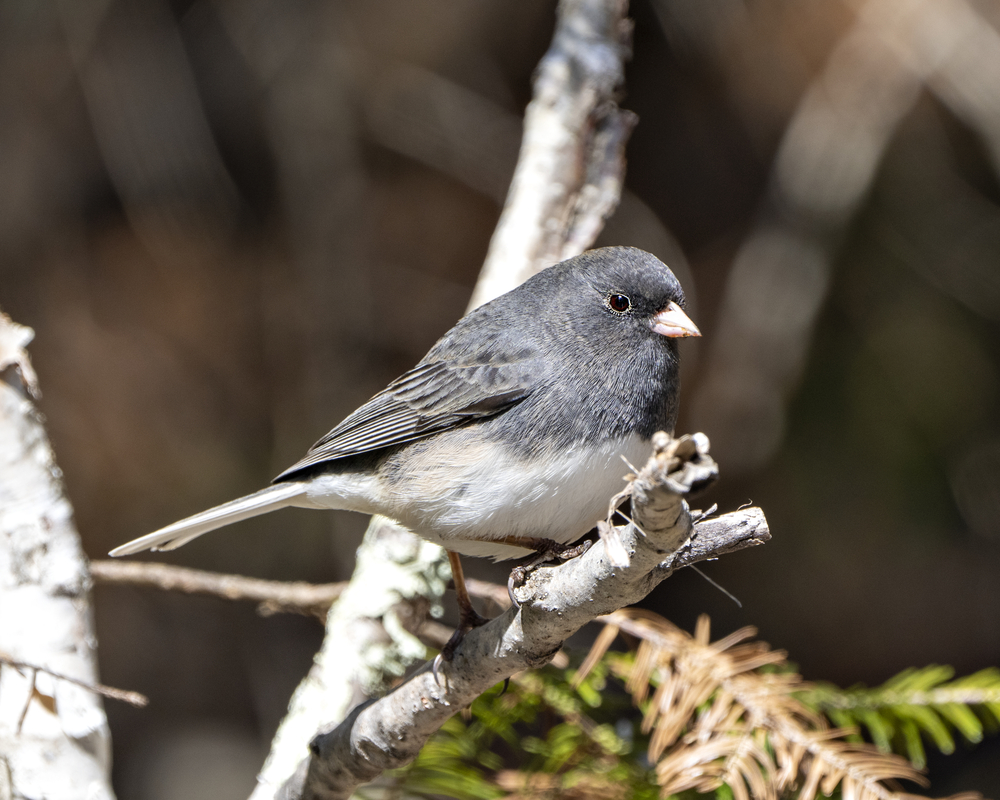
- Scientific Name: Junco hyemalis
- Length: 5.5-6.3 in (14-16 cm)
- Weight: 0.6-1.1 oz (18-30 g)
- Wingspan: 7.1-9.8 in (18-25 cm)
Dark-eyed Juncos are sometimes known as ‘snow birds’ because they appear to be so hardy. Illinois is merely a cold-weather country for this dark gray sparrow that prefers to breed further north. You can see them here between October and May, but most often during the coldest months.
Although there are regional variations of dark-eyed juncos, the ones that you’ll see in Illinois are almost certainly the ‘slate-colored’ variety. Oregon dark-eyed juncos are very rare here.
You can easily attract dark-eyed juncos to your backyard at this time of the year by offering them snacks at your backyard bird feeder.
White-throated Sparrow
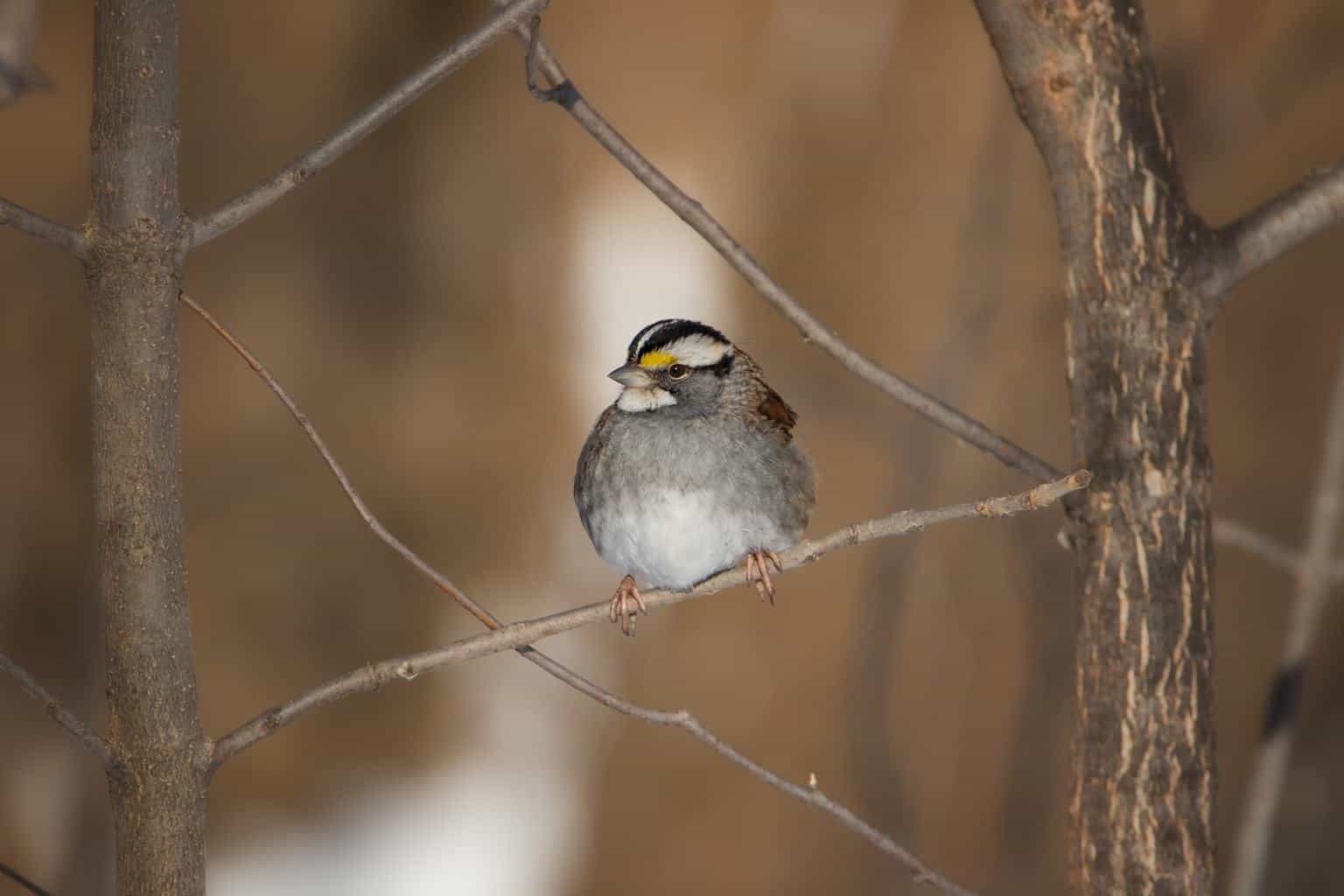
- Scientific Name: Zonotrichia albicollis
- Length: 6.3-7.1 in (16-18 cm)
- Weight: 0.8-1.1 oz (22-32 g)
- Wingspan: 7.9-9.1 in (20-23 cm)
The white-throated sparrow is fairly easy to recognize from the black and white stripes on their head, yellow ‘eyebrows’ (or ‘lores’), and white throat. Some variants, however, may have tan head stripes instead of white.
These medium-sized sparrows are hardy little critters and only stay in Illinois during winter. In summer they nest mainly in Canada, and a few of the northernmost States of America.
These are easy sparrows to attract to backyard and woodland bird feeders, and feeding them can help them to get through the cold winters here!
Chipping Sparrow
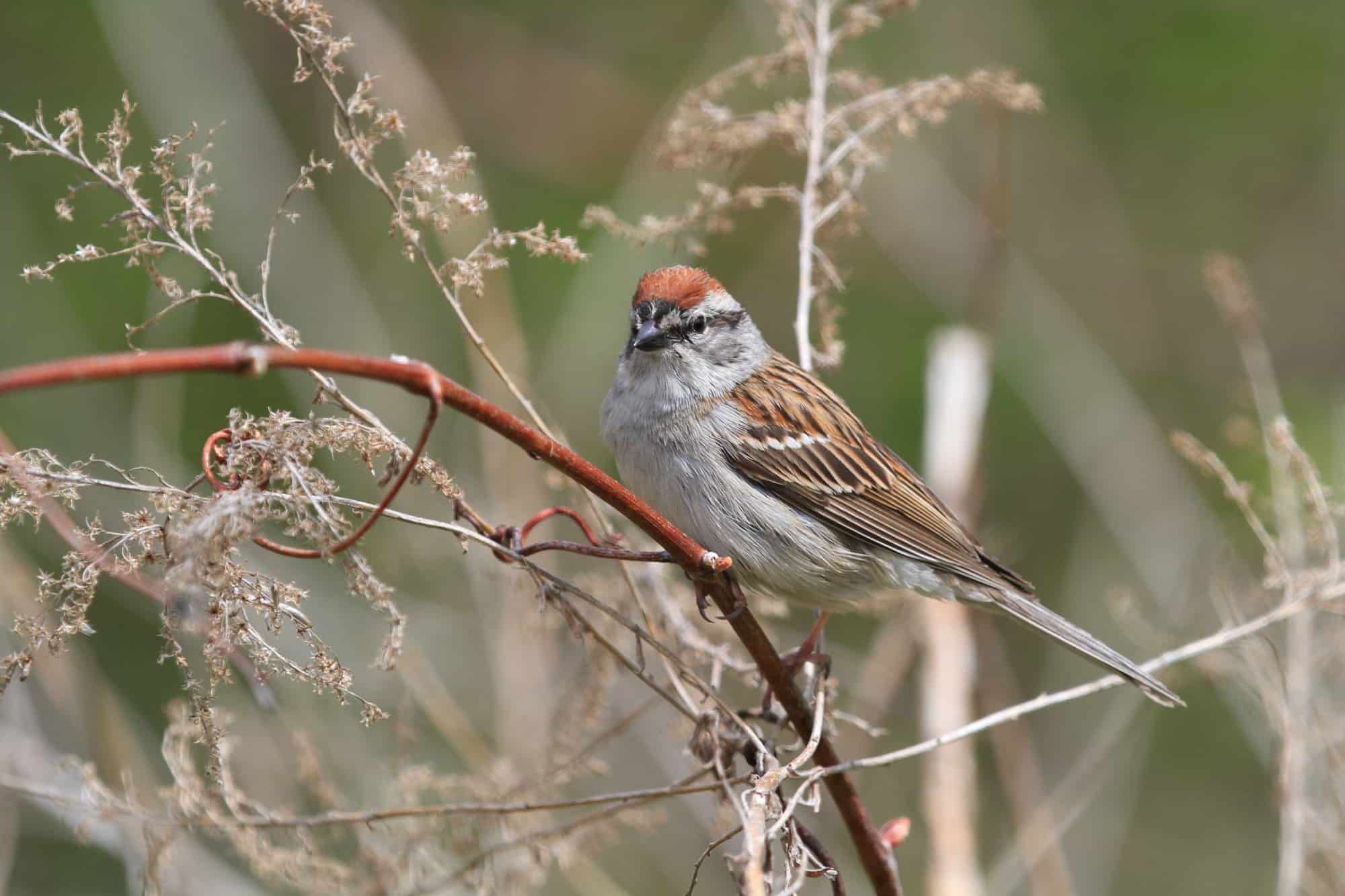
- Scientific Name: Spizella passerina
- Length: 4.7-5.9 in (12-15 cm)
- Weight: 0.4-0.6 oz (11-16 g)
- Wingspan: 8.3 in (21 cm)
During the breeding season, Illinois is full of chipping sparrows busy nesting in shrubs and trees. In winter, most individuals fly to more southerly states and even Central America.
In mild winters, it may be possible to see small populations remaining in the south of the state, and this is likely to increase with climate change.
Chipping sparrows can be recognized by their rusty crown, black eye line, and gray chest. Their stuttered trilling call is also fairly distinctive. Think of the sound of a high-pitched squeaky wheel that needs greasing!
Field Sparrow
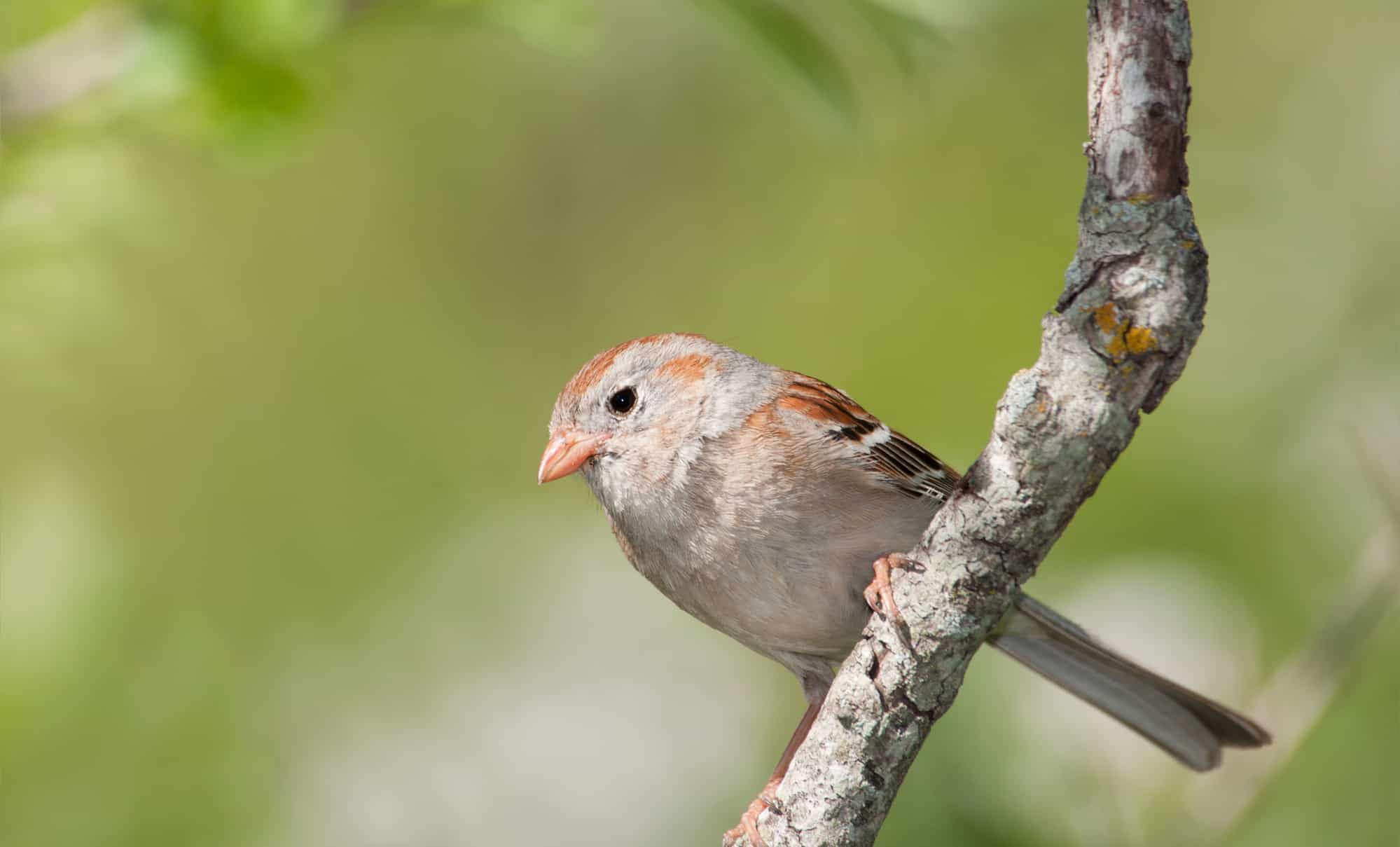
- Scientific Name: Spizella pusilla
- Length: 4.7-5.9 in (12-15 cm)
- Weight: 0.4-0.5 oz (11-15 g)
- Wingspan: 7.9 in (20 cm)
Field sparrows are a common sight in Illinois during the summer when large numbers of them migrate to breed here. In mild winters you can spot them in the southern half of the state, too.
Although this small sparrow is fairly difficult to distinguish by appearance alone, they can be told apart from similar-looking species by their loud, high-pitched call that sounds bizarrely like a metallic bouncing ball coming to a stop!
Field sparrows nest on the ground and, once hatched, their young only take about one week to fledge! Although they are common, their numbers are declining, probably due to the loss of weedy fields that they enjoy inhabiting.
Eastern Towhee

- Scientific Name: Pipilo erythrophthalmus
- Length: 6.8-8.2 in (17.3-20.8 cm)
- Weight: 1.1-1.8 oz (32-52 g)
- Wingspan: 7.9-11.0 in (20-28 cm)
They might not look or sound like a sparrow, but the eastern towhee is just as much part of the New World Sparrows as any of the rest! These beautiful birds have a black head, wings, and tail, dark, ruby red eyes, rusty red flanks, and a white belly.
Although they breed in all parts of the state, you’ll only find eastern towhees in the southern regions of Illinois during winter. Look out for them scratching about in the undergrowth for seeds, snails, millipedes and insects.
An interesting fact about the Eastern Towhee is that they’re often the victims of brood-parasitism of Brown-Headed Cowbirds. Just like cuckoos, cowbirds remove the Eastern towhee’s eggs from its nest and lay their own. If the towhees don’t notice, they’ll end up raising the cowbird’s young instead of their own!
American Tree Sparrow
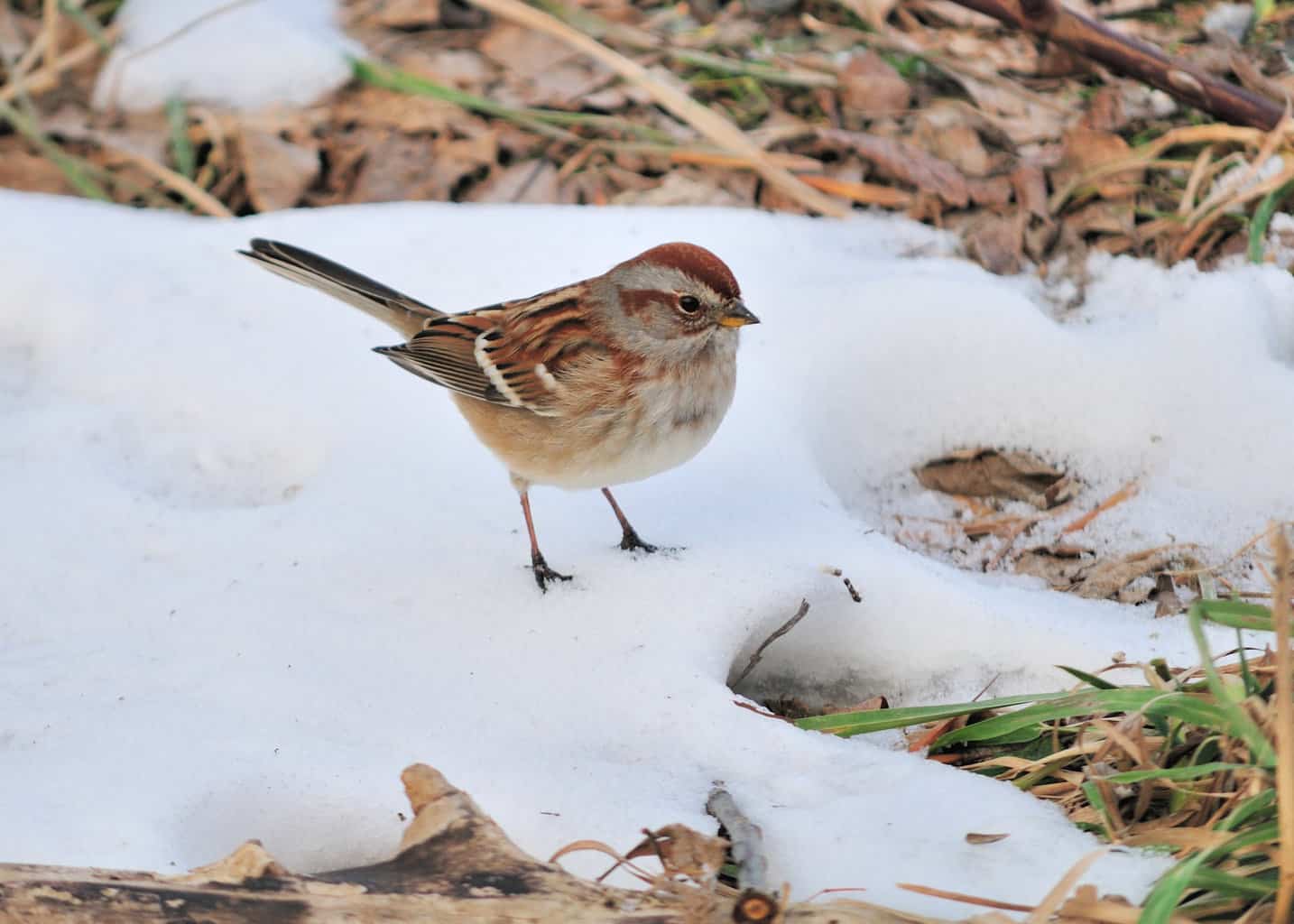
- Scientific Name: Spizelloides arborea
- Length: 5.5 in (14 cm)
- Weight: 0.5-1.0 oz (13-28 g)
- Wingspan: 9.4 in (24 cm)
This sparrow’s name is a misnomer. It was so-called by European settlers who thought that it reminded them of their native tree sparrow, but in fact, the American tree sparrow spends little time in trees, and you’re more likely to see them near the ground!
These birds are closely related to the field sparrow and have similar plumage. They are substantially larger, however, and have a different song that’s sweet and pleasant to listen to.
The American Tree Sparrow has one of the most northerly geographical ranges of any sparrow. You’ll only find them in Illinois during the winter, and in summer their nesting grounds extend well into the arctic circle!
White-crowned Sparrow
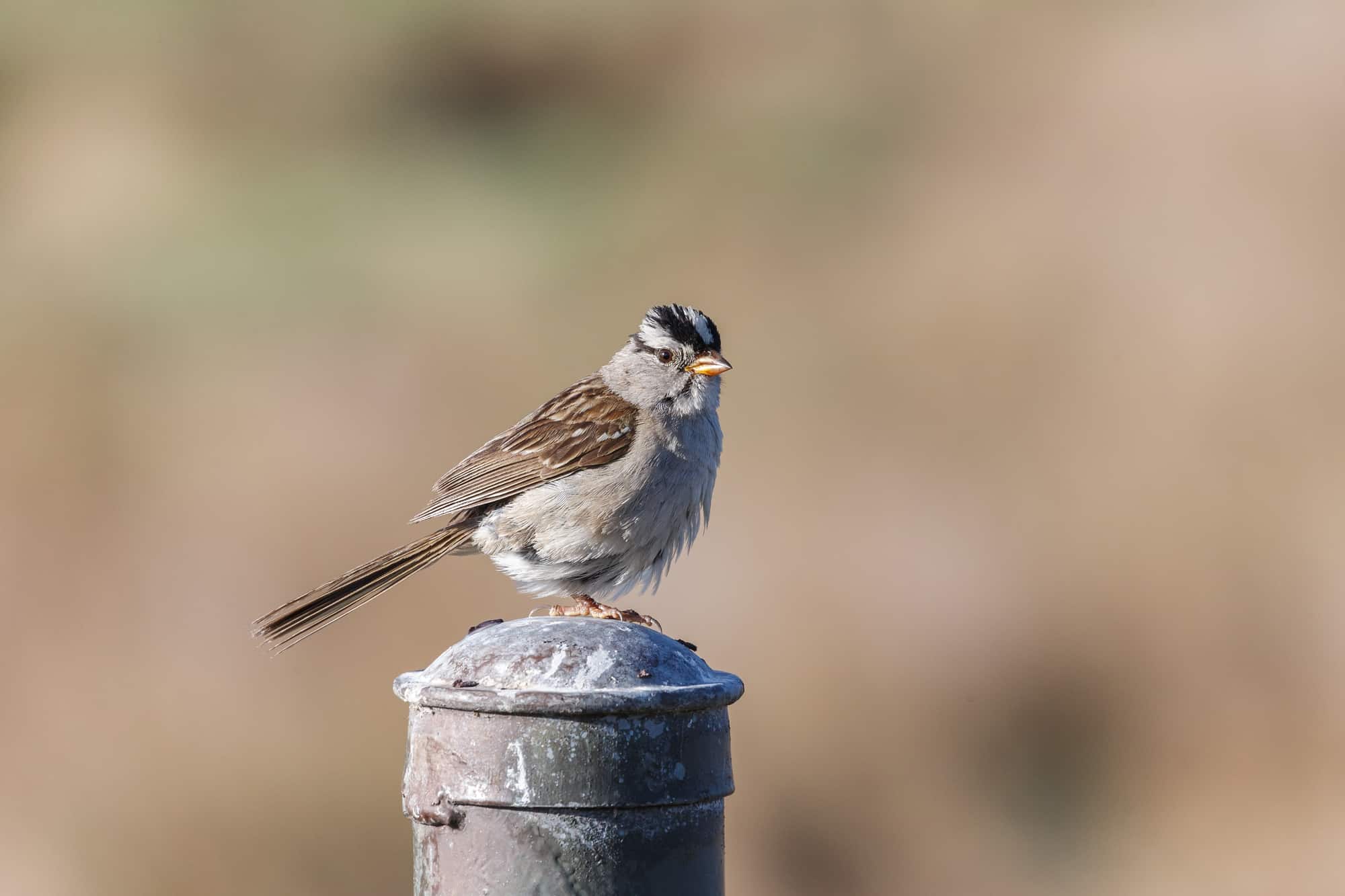
- Scientific Name: Zonotrichia leucophrys
- Length: 5.9-6.3 in (15-16 cm)
- Weight: 0.9-1.0 oz (25-28 g)
- Wingspan: 8.3-9.4 in (21-24 cm)
The white-crowned sparrow is the largest member of the Zonotrichia tribe of sparrows. They’re fairly easy to recognize by their black and white striped head, and orange-pink bill.
Although white-crowned sparrows are more common further south during winter, Illinois has a smaller population of them owing to its colder winters. These birds don’t overwinter much further north than this, and spend their summers in the far north of Canada, Alaska, and the Rocky Mountains.
You can find these largish sparrows moving around in large flocks over weedy and brushy areas and you can also attract them to your backyard by offering them sunflower seeds, millet, and other types of bird food.
Savannah Sparrow
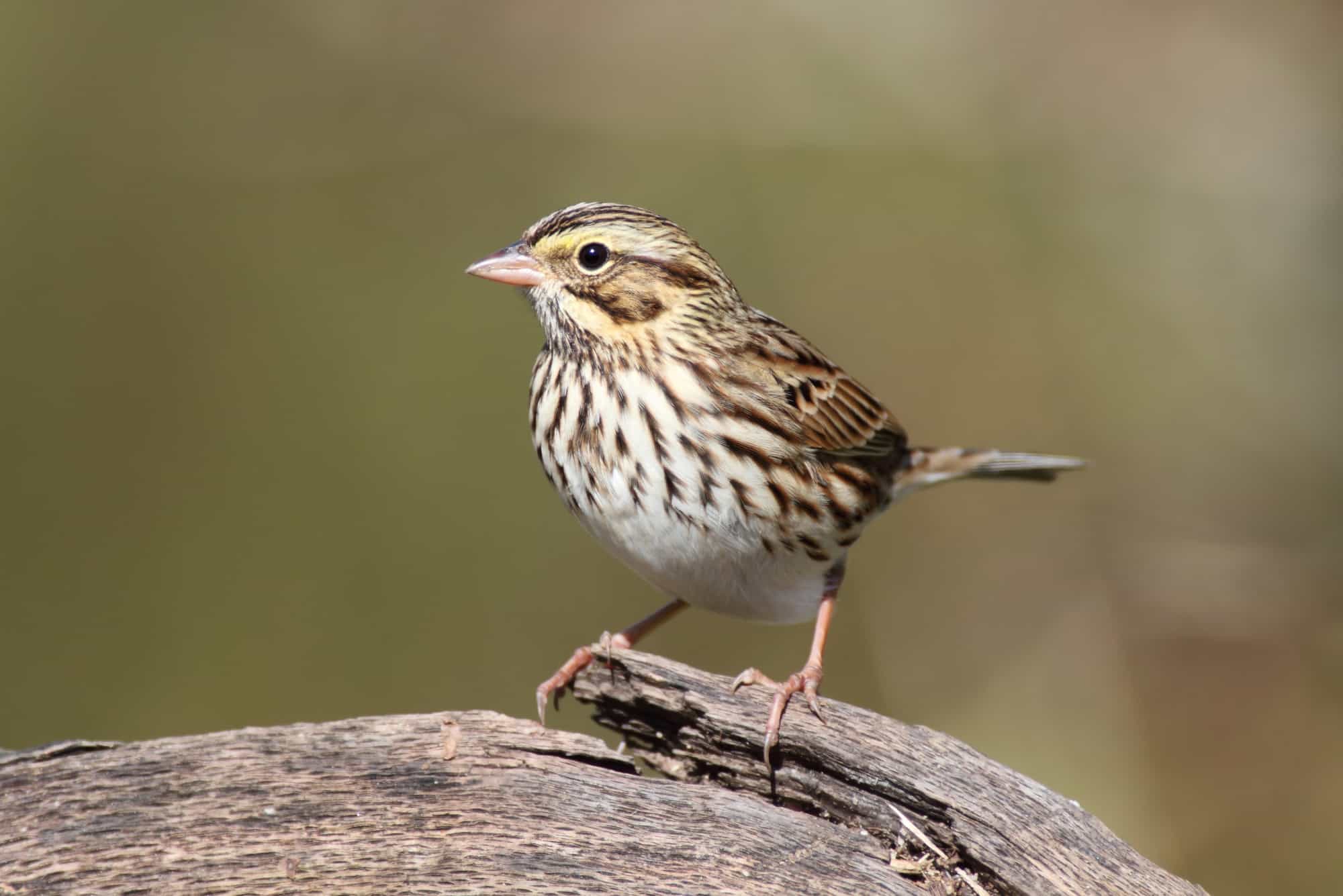
- Scientific Name: Passerculus sandwichensis
- Length: 4.3-5.9 in (11-15 cm)
- Weight: 0.5-1.0 oz (15-28 g)
- Wingspan: 7.9-8.7 in (20-22 cm)
Savannah sparrows are untamed grassland birds that prefer to stay away from human habitation, so it’s not surprising to find them in the prairies of Illinois!
The north of the state represents their southernmost breeding ground, and the south of the state is the northern edge of their wintering grounds. According to the Sibley Guide To Birds, they’re only present in central Illinois during migration.
- Sibley Guide To Birds, 2nd Ed
- Sibley, David Allen (Author)
- English (Publication Language)
Last update on 2024-07-27 / Affiliate links / Images from Amazon Product Advertising API
Although they look rather like song sparrows, they can be identified through a pair of binoculars by the yellow wash around their face.
Fox Sparrow

- Scientific Name: Passerella iliaca
- Length: 5.9-7.5 in (15-19 cm)
- Weight: 0.9-1.6 oz (26-44 g)
- Wingspan: 10.5-11.4 in (26.7-29 cm)
Fox sparrows are large, thrush-like sparrows, with broad wingspans and speckled chests. They even whistle and scratch about in undergrowth for food rather like thrushes do!
Although they’re a more common bird further south, you’ll only see small numbers of fox sparrows in Southern Illinois during the colder months. In the spring and summer, they fly to Northern Canada and Alaska for breeding.
While there are different variations of fox sparrows on the west coast, the subspecies you’ll find here is the classic red-tinted version from which this bird got its name.
Henslow’s Sparrow
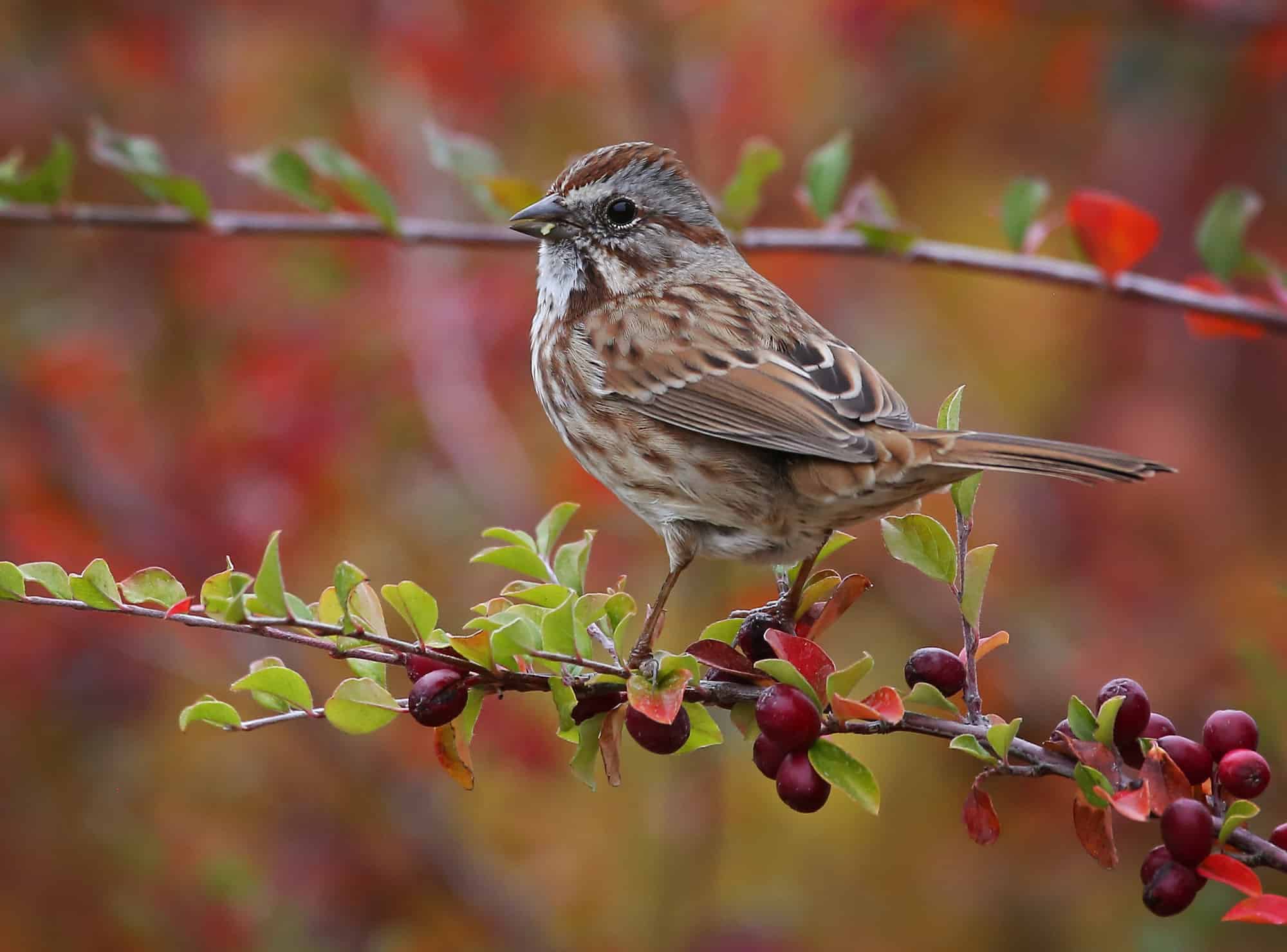
- Scientific Name: Centronyx henslowii
- Length: 4.75 – 5.25 in (12 – 13 cm)
- Weight: 0.5 oz – (14 g)
- Wingspan: 6-7 in – (15 – 18 cm)
A tiny sparrow with a short tail and a large head, Henslow’s sparrow is one of the smallest sparrows in North America. Its secretive nature also makes it difficult to spot!
Illinois lies at the heart of the tight breeding range of these birds that spend their winters in the southeast of the USA. You can find them nesting among dense clumps of tall grass in the damp meadows and prairies that they dwell in. Sadly this species is declining due to the loss of wild grasslands.
Since Henslow’s sparrow is so small, shy, and well-camouflaged, it should be considered a prized spotting. Even their song is quiet and subtle, sounding more like someone hiccuping or a mouse squeaking than a bird!
Grasshopper Sparrow
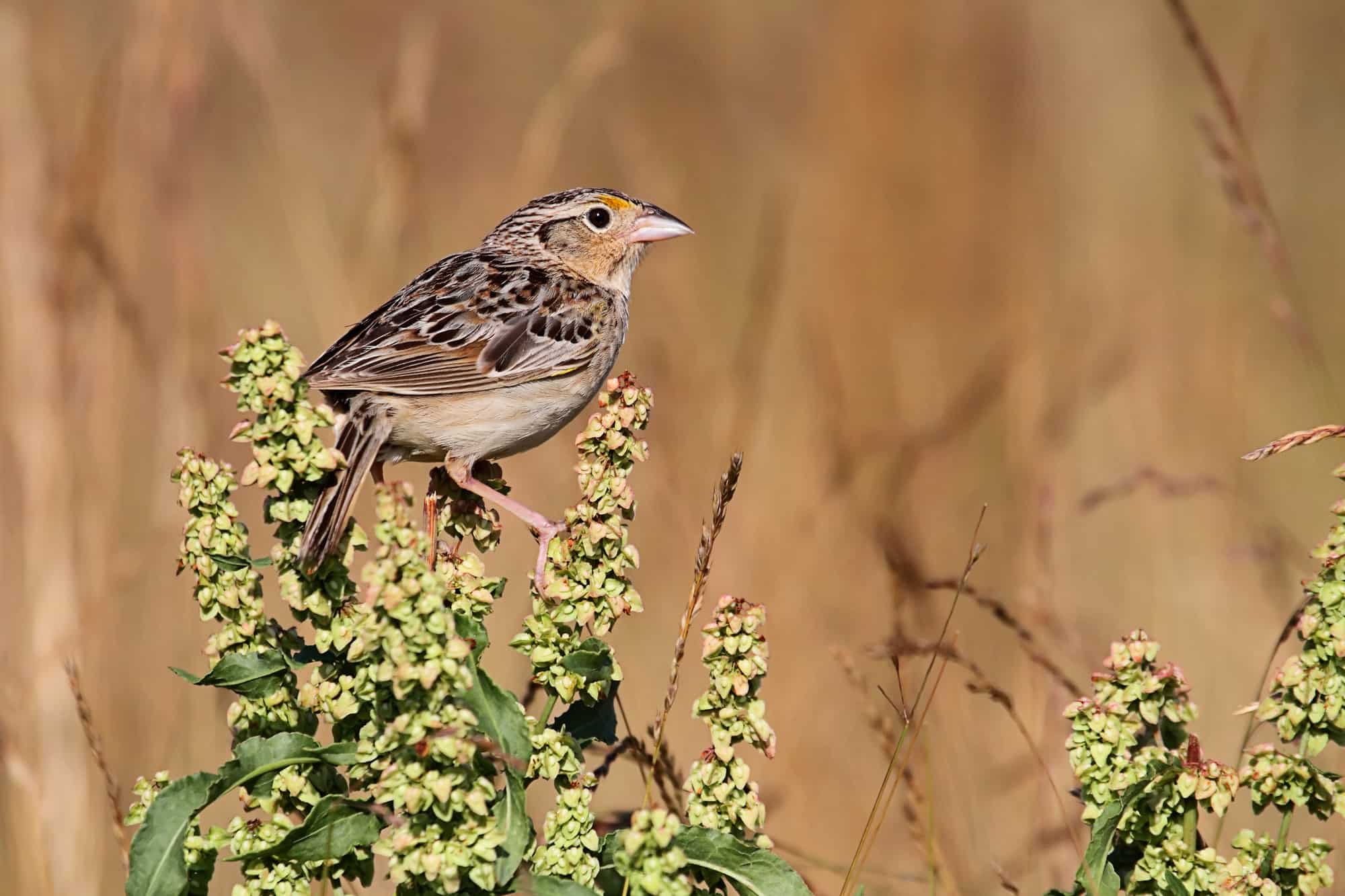
- Scientific Name: Ammodramus savannarum
- Length: 4.3-4.5 in (10.8-11.5 cm)
- Weight: 0.5-0.7 oz (14-20 g)
- Wingspan: 7.9 in (20 cm)
A close cousin of Henslow’s sparrow, the grasshopper sparrow not only sounds like a grasshopper but also loves feeding on them during the summer when they nest in dry grasslands! They can be told apart from the former species by their larger size and lack of black streaks on their underside.
Summer is the only time of year when you’ll find grasshopper sparrows in Illinois – these warmth-loving birds spend their winters only in the southernmost United States and Central America.
As a solitary and secretive species that rarely come close to human habitation, you might need a good pair of binoculars to enjoy watching them!
Vesper Sparrow
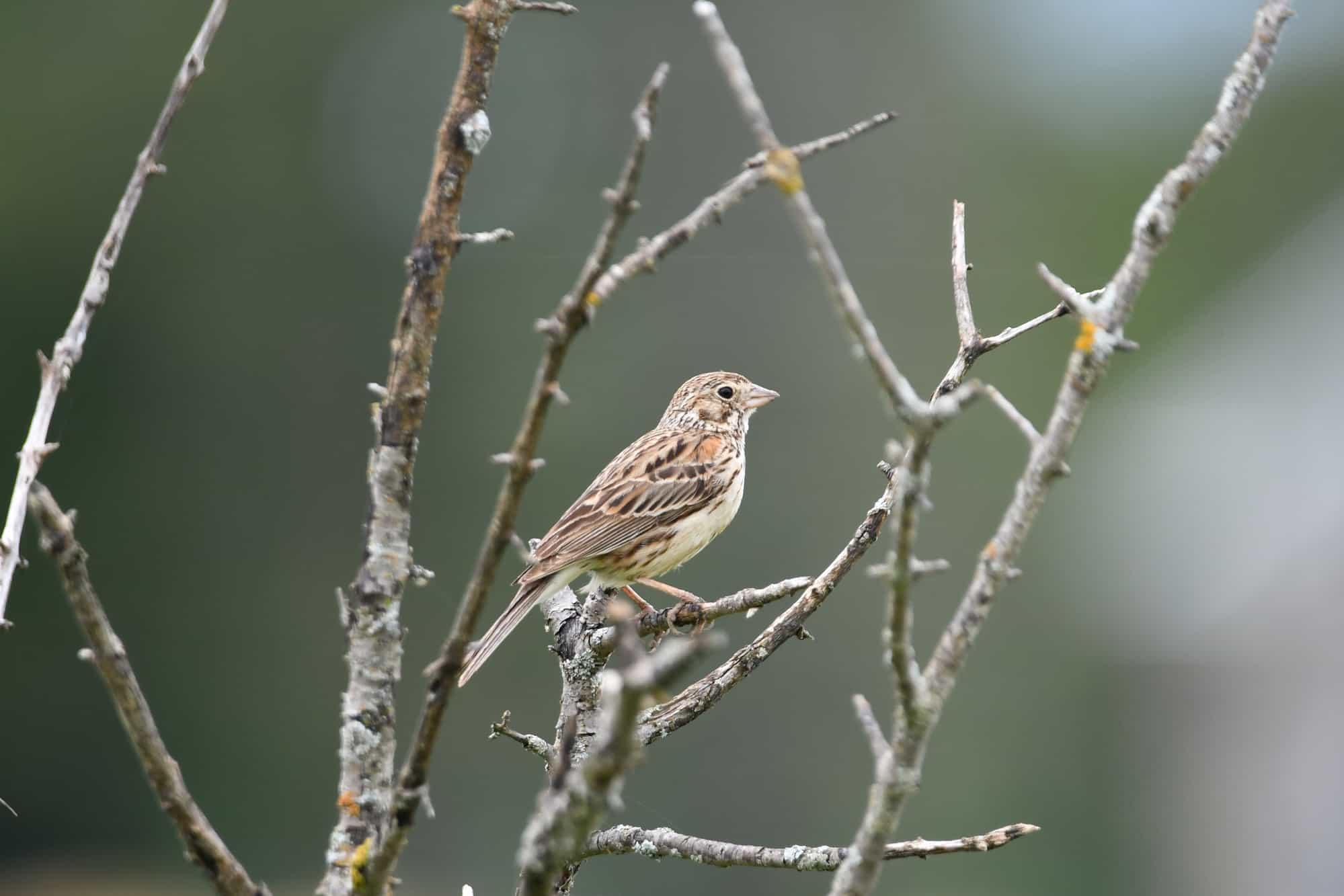
- Scientific Name: Pooecetes gramineus
- Length: 5.1-6.3 in (13-16 cm)
- Weight: 0.7-1.0 oz (20-28 g)
- Wingspan: 9.4 in (24 cm)
The vesper sparrow is similar in appearance to the Savannah sparrow, but they’re slightly larger, without the yellow wash on their face.
Although they’re more common in the west of the country, vesper sparrows are relatively rare in Illinois. You’ll only find them here during the summer when they nest in all areas except the southern quarter of the state. In winter they head south to the Southern United States and Central America.
Vesper sparrows nest in extensive grasslands, meaning the preservation of wild meadows will be critical for them to prosper for future generations to enjoy.
Lark Sparrow
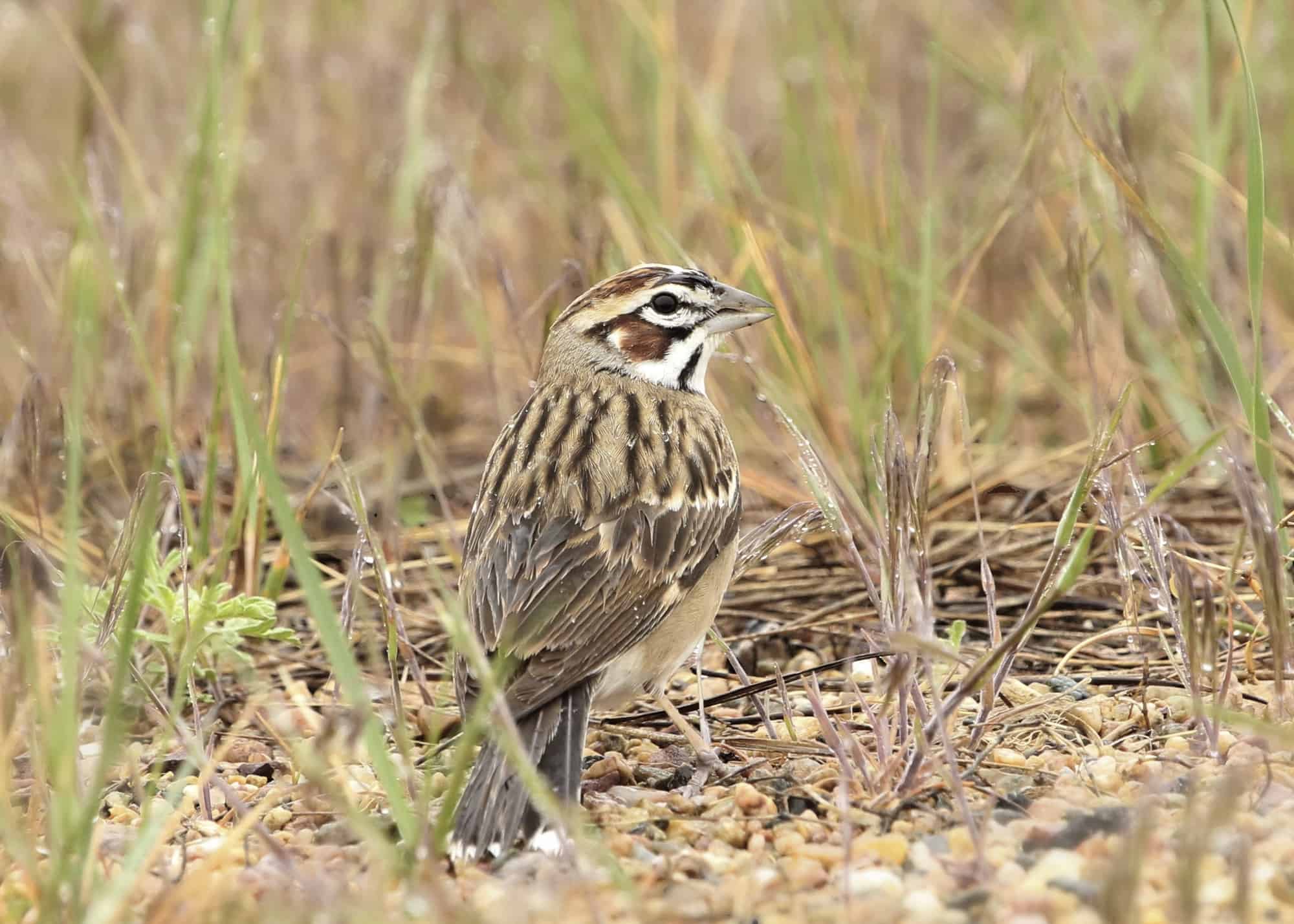
- Scientific Name: Chondestes grammacus
- Length: 5.9-6.7 in (15-17 cm)
- Weight: 0.8-1.2 oz (24-33 g)
- Wingspan: 11.0 in (28 cm)
Not to be confused with their striking cousin the lark bunting, lark sparrows are most easily recognized by their large size, bright white underside with a dark spot on their chest, and white tips on their tail. Closer inspection also reveals distinct black stripes on their face and tan crown feathers.
These birds prefer open grassy areas with scattered trees. They can be seen foraging on grazed livestock farms as well as on golf courses or well-kept lawns!
Illinois represents the eastern extent of the lark sparrow’s native breeding range, and as such, they are not very common birds here compared to territories further west. During nesting, both males and females collect materials such as grass and small twigs, but only females are permitted to construct the nest!
LeConte’s Sparrow
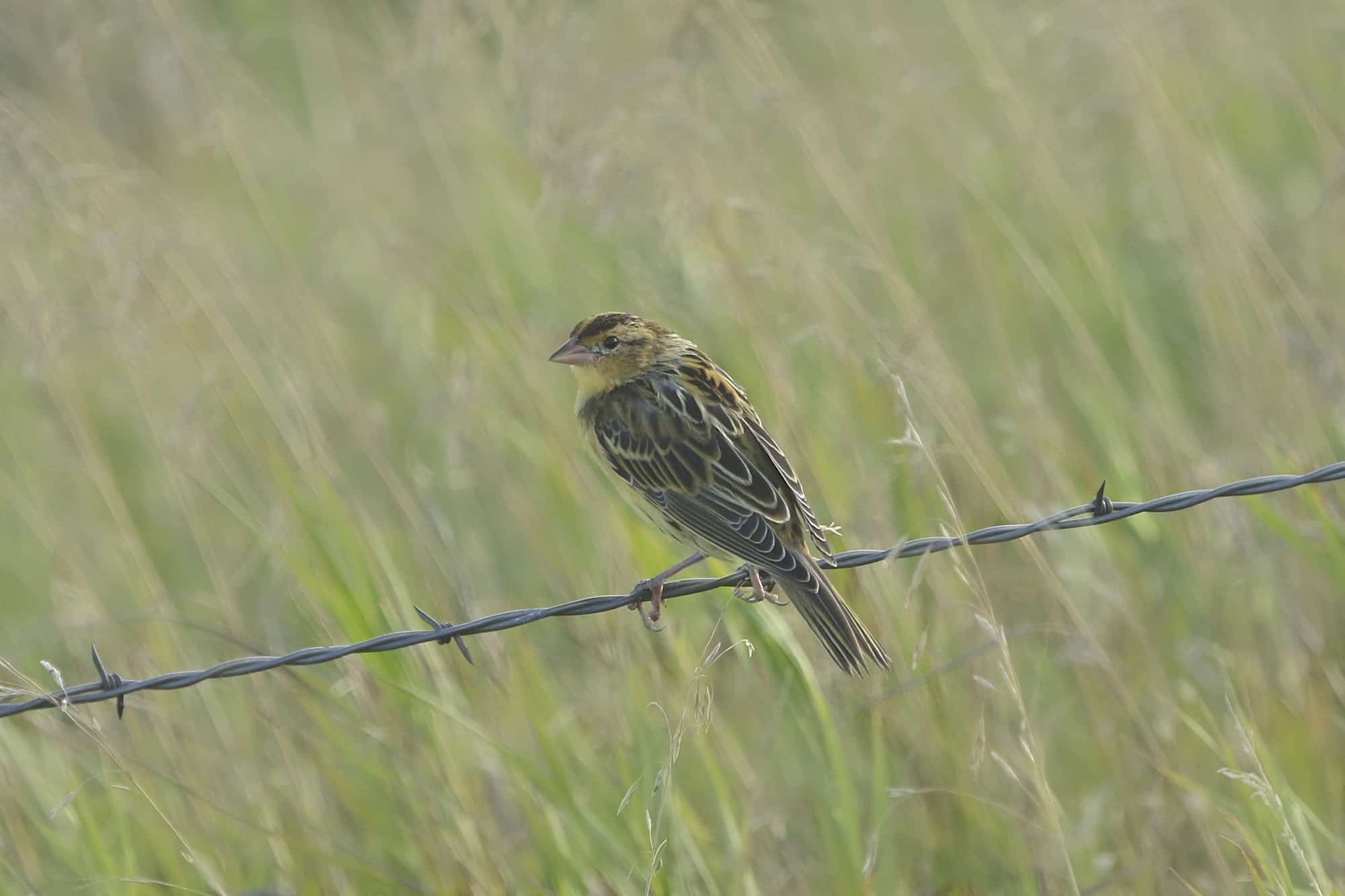
- Scientific Name: Ammospiza leconteii
- Length: 4.7-5.1 in (12-13 cm)
- Weight: 0.4-0.6 oz (12-16.3 g)
- Wingspan: 6.3-7.1 in (16-18 cm)
A close cousin of the grasshopper sparrow and Henslow’s sparrow, LeConte’s sparrow is another tiny bird of wild, grassy habitats. It can be told apart from its relatives by its crisp, dark streaks on its flanks and smaller bill.
This species also prefers to inhabit damper grasslands than grasshopper sparrows, but dryer than Nelson’s sparrow. Its secretive nature makes it difficult to spot except when it’s singing – a song that sounds more like an insect than a bird!
LeConte’s sparrow is a very rare sighting in Southern Illinois, where it will only occasionally reside during mild winters. More of them can be seen passing through the state, however, during the spring and fall migration seasons.
Spotted Towhee
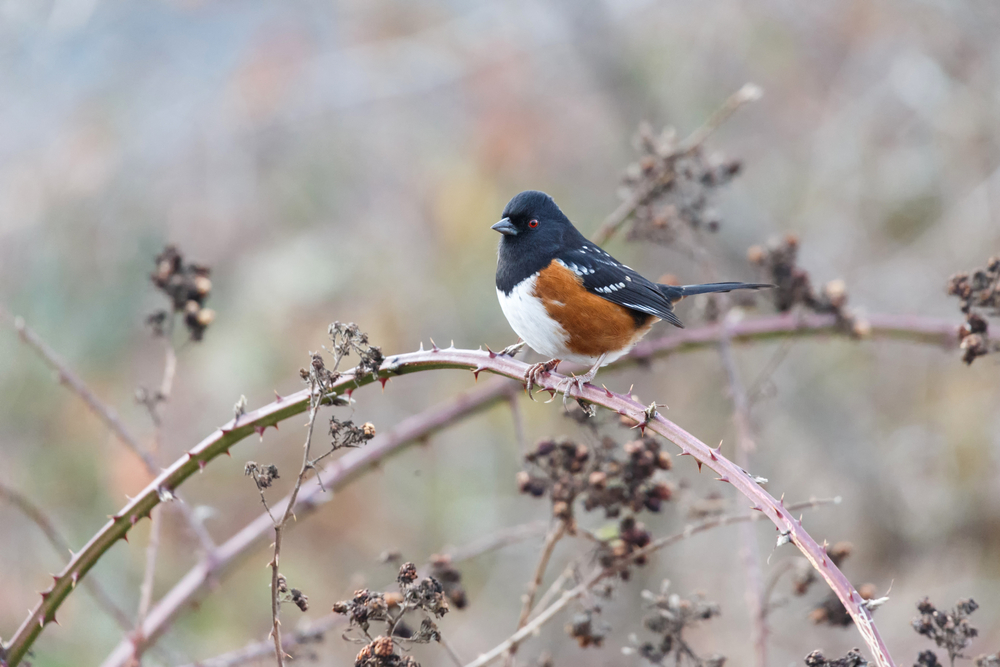
- Scientific Name: Pipilo maculatus
- Length: 6.7-8.3 in (17-21 cm)
- Weight: 1.2-1.7 oz (33-49 g)
- Wingspan: 11.0 in (28 cm)
Spotted towhees are one of the hardest sparrows to spot in Illinois for two reasons.
Firstly, they are only very occasional wandering vagrants here during the winter. Secondly, they look very similar to the native eastern towhee which is far more common in Illinois!
The clue in telling the difference between the two is in the name. Spotted towhees have white spots on their brown or black wings, whereas eastern towhees only have a tiny white patch on the wings. Most other features and behavior, however, are very alike.
Since these two species are genetically so similar, they can produce hybrid offspring which share features from both parents!
Sparrows Only Seen in Illinois During Migration
There are five species of sparrow noted as occurring regularly in Illinois during migration, but that rarely stop for long here:
- Nelson’s sparrows and swamp sparrows – two small sparrow species that you’re most likely to see in or around wetland habitats than near human habitation.
- The clay-colored sparrow, which in truth, is more of a clay color in its autumn plumage than in the spring.
- Harris sparrow with its trademark deep black face and throat.
- The delightful Lincoln’s sparrow, which has one of the sweetest songs of any sparrow species in North America.
Conclusion
There are 17 resident sparrows in Illinois, as well as 5 sparrows that pass through the state during migration. If you are a local here, perhaps you could try to spot them all? The last few on our list may take some dedicated effort, but then that’s half the fun of being a good birdwatcher!
Offering bird food at your backyard bird feeder is one of the best ways to get to know sparrows better, and it might just help them get through the cold winters, too!
Sparrows only make up 22 of the 200+ bird species that can be found in Illinois. To learn more about other fascinating birds that live here such as the red crossbill, indigo bunting, and belted kingfisher, be sure to check out our dedicated guide to 35 beautiful birds in Illinois.

